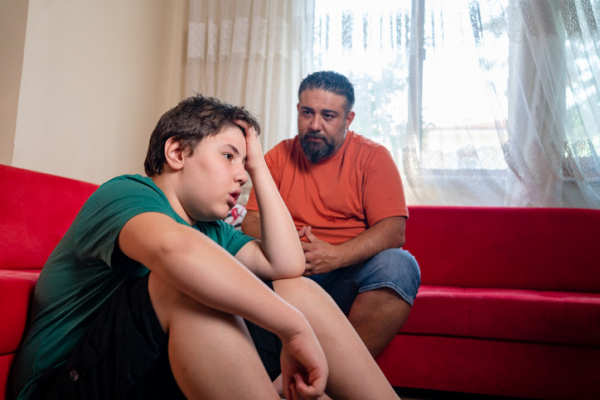Co-regulation: Helping children and teens navigate big emotions

When preschoolers are melting down or teens are slamming doors, parents face two difficult tasks: keeping themselves composed and supporting their kids’ ability to self-soothe while building skills to handle future challenges.
These abilities are at the heart of co-regulation, a parenting tool that requires patience and practice. But what exactly is involved, and how does it help support children and teens wrestling with big emotions?
What is co-regulation?
“Co-regulation is a supportive, interactive, and dynamic process,” says Lauren Marchette, a child, adolescent, and family psychologist and a lecturer in psychiatry at Harvard Medical School.
Through warm and responsive interactions, caregivers help young people learn better ways to regulate their emotions during the inevitable upsets and challenges of life. “At its heart, co-regulation is connecting with a child who’s in distress and being able to evaluate what that child needs in the moment to help calm themselves.”
But before a parent or trusted adult can help a child, they need to understand — and possibly expand — their own emotional skills and limitations. Emotions are often contagious, whether a person is upset or sharing a sense of calm.
“The tricky part of co-regulation is that adults have to recognize how they’re feeling and be able to regulate their own emotions in difficult moments so they can help children to gain these same skills,” Marchette says. “But this will be so important for kids to develop healthy relationships over time, and affects how people do in school, work, and life in general.”
How does building emotional skills help children and teens?
As children grow up, they learn different skills — how to build a block tower, play a sport, or solve a math equation. They also learn emotional skills: how to recognize and handle feelings of anger or anxiety, for example.
Known as self-regulation, such emotional skills are truly the basis of wellness in life, Marchette says. By consistently practicing co-regulation, parents and other trusted adults foster self-regulation skills in kids.
The list of self-regulation skills is wide-ranging, involving
- emotional awareness and literacy, including the ability to identify emotions
- emotional regulation skills such as self-soothing
- perspective-taking, or the ability to "walk in another’s shoes”
- social skills such as taking turns and practicing patience
- paying attention and remaining focused when needed
- problem-solving
- thinking flexibly
- time management skills
- goal-setting.
What are the potential benefits of co-regulation?
Co-regulation enables kids to eventually learn to
- handle stress
- resist immediate gratification
- avoid hasty, ill-informed decisions
- make and stick to plans
- solve problems
- adapt to challenges
- take healthy risks.
Some research suggests that having better self-regulation skills is linked to more positive outcomes in life, such as higher income and lower rates of substance use and violence.
Who might especially benefit from co-regulation?
Everyone wins when kids are better able to navigate frustrations and manage their reactions to their thoughts and feelings. Parents, teachers, coaches, guidance counselors, mentors, and other adults who interact closely with children also stand to benefit.
As for kids themselves, it’s hard to think of any whose lives won’t be improved by adults who have invested themselves in practicing co-regulation, Marchette says.
But practicing co-regulation skills with certain children and adolescents — including those whose families are experiencing economic hardship, substance abuse, divorce, or other distressing situations — can be especially important.
Is there evidence that co-regulation works?
“While co-regulation is built upon a solid theoretical framework, not many studies have delved into its effectiveness — at least across all age groups,” Marchette says. “Research that does focuses mainly on infants and preschoolers.”
“Much less is known about how co-regulation interventions work for older youth,” she says. “The research is trying to catch up to what we know from years of clinical experience.”
How can a parent coach a child through co-regulation?
Co-regulation doesn’t stand alone as a skill. It relies on fostering a warm, responsive relationship with children, providing structure, and setting limits. “Children benefit from consistent, predictable routines with clear expectations and consequences,” Marchette says.
When a child begins experiencing big emotions, a co-regulation response will look different depending on the child and circumstances. But the steps to take are similar.
“First, the parent needs to pause and self-regulate their own emotions, such as by taking a deep breath,” Marchette explains. “The next steps are validating the child’s feelings, observing the child’s response, and then deciding how to respond next, including verbally and nonverbally, such as with a touch.”
Marchette offers an example based on her own practice: 12-year-old “Eric” is tackling a writing assignment in his bedroom when his mother suddenly hears loud noises. She walks to his door and finds him throwing a stapler, notebook, and container of pens off his desk. “What’s wrong with me?” he yells. “I suck at writing and I hate school!” Then Eric puts his head down on his desk.
The sixth grader’s mom knows he needs help calming down, so she pauses and takes a deep breath. Then she walks over and whispers his name, placing her hand on his shoulder. After more silence, Eric gradually starts sitting up in his chair. “I can tell how frustrated you are with this assignment,” she says to him, validating his feelings. “It must be a really challenging one.”
Eric’s mother knows he needs a break after he mutters, “I can’t do it.” She suggests a getting a glass of ice-cold water, and Eric glumly follows her to the kitchen. After the break, they can re-evaluate if Eric is ready to return to his homework or needs further coping strategies — like a walk outside or a round of jumping jacks — to get his frustration out.
What resources can help parents practice co-regulation?
The Administration for Children and Families offers a free Co-Regulation in Action video series. And some therapists — especially those who specialize in behavioral parent training or cognitive behavioral therapy — can help parents who feel their skills need a boost.
It’s worth noting that it can be hard to have sufficient resources — emotional, financial, and other supports — to practice co-regulation consistently. Those who wish to try should give themselves some grace as they learn the process. “Even parents who are thinking their own self-regulation skills aren’t where they want them to be should realize this is a muscle they can strengthen,” Marchette says. “It’s important to have that growth mindset.”
About the Author

Maureen Salamon, Executive Editor, Harvard Women's Health Watch
Maureen Salamon is executive editor of Harvard Women’s Health Watch. She began her career as a newspaper reporter and later covered health and medicine for a wide variety of websites, magazines, and hospitals. Her work has … See Full Bio View all posts by Maureen Salamon
About the Reviewer

Howard E. LeWine, MD, Chief Medical Editor, Harvard Health Publishing
Dr. Howard LeWine is a practicing internist at Brigham and Women’s Hospital in Boston, Chief Medical Editor at Harvard Health Publishing, and editor in chief of Harvard Men’s Health Watch. See Full Bio View all posts by Howard E. LeWine, MD